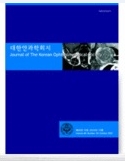- 영문명
- Relationship between Clinical History Method and Orbscan Ⅱ for Measuring Corneal Power after LASIK
- 발행기관
- 대한안과학회
- 저자명
- 구희찬 조소현 김효진 김진형 주천기,Hee-Chan Ku, M.D., So-Hyun Cho, B.S., Hyo-Jin Kim, M.S., Jin-Hyung Kim, M.D., Choun-Ki Joo, M.D., PhD.
- 간행물 정보
- 『대한안과학회지』Ophthalmological Society,volume46,number4, 581~588쪽, 전체 8쪽
- 주제분류
- 인문학 > 역사학
- 파일형태
- 발행일자
- 2005.04.30

국문 초록
영문 초록
Purpose: To evaluate the relation between clinical history method and Orbscan Ⅱ for corneal power measurement after laser in situ keratomileusis (LASIK). Methods: A total of 77 consecutive eyes of 43 patients who were treated with LASIK for myopia were followed up for at least 6 months. Corneal power by clinical history methods (CK) was compared with 3.0 mm zones of simulated keratometry (Sim-K), with 0.5, 1.0, 1.5, 2.0 and 3.0 mm zones of axial power maps (AP) and with 2.0, 3.0, 3.5, 4.0 and 5.0 mm zones of total optical power maps (TOP). Results: Sim-K and all AP-map zones using Orbscan II were significantly higher (P<.001) than the CK value, while all TOP-map zones were significantly lower (P<.001) than the CK value. Among them, 3.0 and 4.0 mm TOP-map zones showed the highest correlation with the corneal power by CK (r2=0.889, P<.001; r2=0.889, P<.001). The correlation was higher with 3.0 mm TOP-map zone (r2=0.800, P<.001) than with 4.0 mm TOP-map zone (r2=0.793, P<.001) in high myopia patients. Conclusions: Although 3.0 and 4.0 mm TOP-map zones of Orbscan II were correlated highly with the CK value, these correlations were relatively low in high myopia patients and 3.0 mm TOP-map zone was better correlated than 4.0 mm TOP-map zone in these patients.
목차
해당간행물 수록 논문
참고문헌
최근 이용한 논문
교보eBook 첫 방문을 환영 합니다!

신규가입 혜택 지급이 완료 되었습니다.
바로 사용 가능한 교보e캐시 1,000원 (유효기간 7일)
지금 바로 교보eBook의 다양한 콘텐츠를 이용해 보세요!



